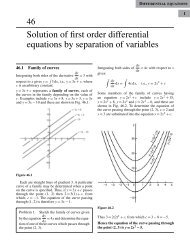integration
You also want an ePaper? Increase the reach of your titles
YUMPU automatically turns print PDFs into web optimized ePapers that Google loves.
Integral calculus<br />
38<br />
Some applications of <strong>integration</strong><br />
38.1 Introduction<br />
There are a number of applications of integral calculus<br />
in engineering. The determination of areas, mean<br />
and r.m.s. values, volumes, centroids and second<br />
moments of area and radius of gyration are included<br />
in this chapter.<br />
38.2 Areas under and between curves<br />
In Fig. 38.1,<br />
total shaded area =<br />
∫ b<br />
a<br />
f (x)dx −<br />
∫ c<br />
b<br />
+<br />
f (x)dx<br />
∫ d<br />
c<br />
f (x)dx<br />
co-ordinate value needs to be calculated before a<br />
sketch of the curve can be produced. When x = 1,<br />
y =−9, showing that the part of the curve between<br />
x = 0 and x = 4 is negative. A sketch of<br />
y = x 3 − 2x 2 − 8x is shown in Fig. 38.2. (Another<br />
method of sketching Fig. 38.2 would have been to<br />
draw up a table of values).<br />
Shaded area<br />
∫ 0<br />
∫ 4<br />
= (x 3 − 2x 2 − 8x)dx − (x 3 − 2x 2 − 8x)dx<br />
−2<br />
0<br />
[ x<br />
4<br />
] 0 [<br />
=<br />
4 − 2x3<br />
3 − 8x2 x<br />
4<br />
] 4<br />
−<br />
2 −2 4 − 2x3<br />
3 − 8x2<br />
2 0<br />
(<br />
= 6 2 ) (<br />
− −42 2 )<br />
= 49 1 square units<br />
3 3 3<br />
Figure 38.2<br />
Figure 38.1<br />
Problem 1. Determine the area between the<br />
curve y = x 3 − 2x 2 − 8x and the x-axis.<br />
y = x 3 −2x 2 −8x = x(x 2 −2x−8) = x(x+2)(x−4)<br />
When y = 0, x = 0or(x + 2) = 0or(x − 4) = 0,<br />
i.e. when y = 0, x = 0or−2 or 4, which means that<br />
the curve crosses the x-axis at 0, −2, and 4. Since<br />
the curve is a continuous function, only one other<br />
Problem 2. Determine the area enclosed<br />
between the curves y = x 2 + 1 and y = 7 − x.<br />
At the points of intersection the curves are equal.<br />
Thus, equating the y values of each curve gives:<br />
x 2 + 1 = 7 − x<br />
from which, x 2 + x − 6 = 0<br />
Factorising gives (x − 2)(x + 3) = 0<br />
from which x = 2 and x =−3










